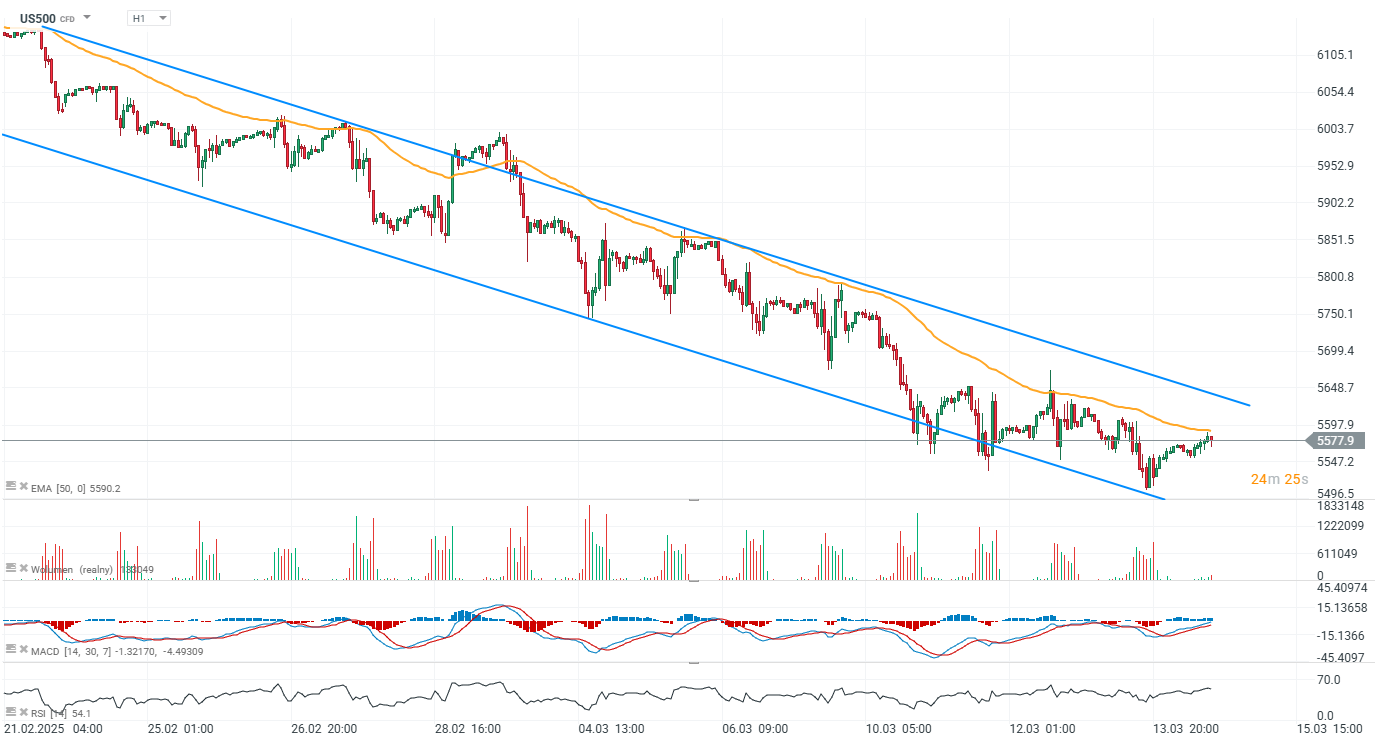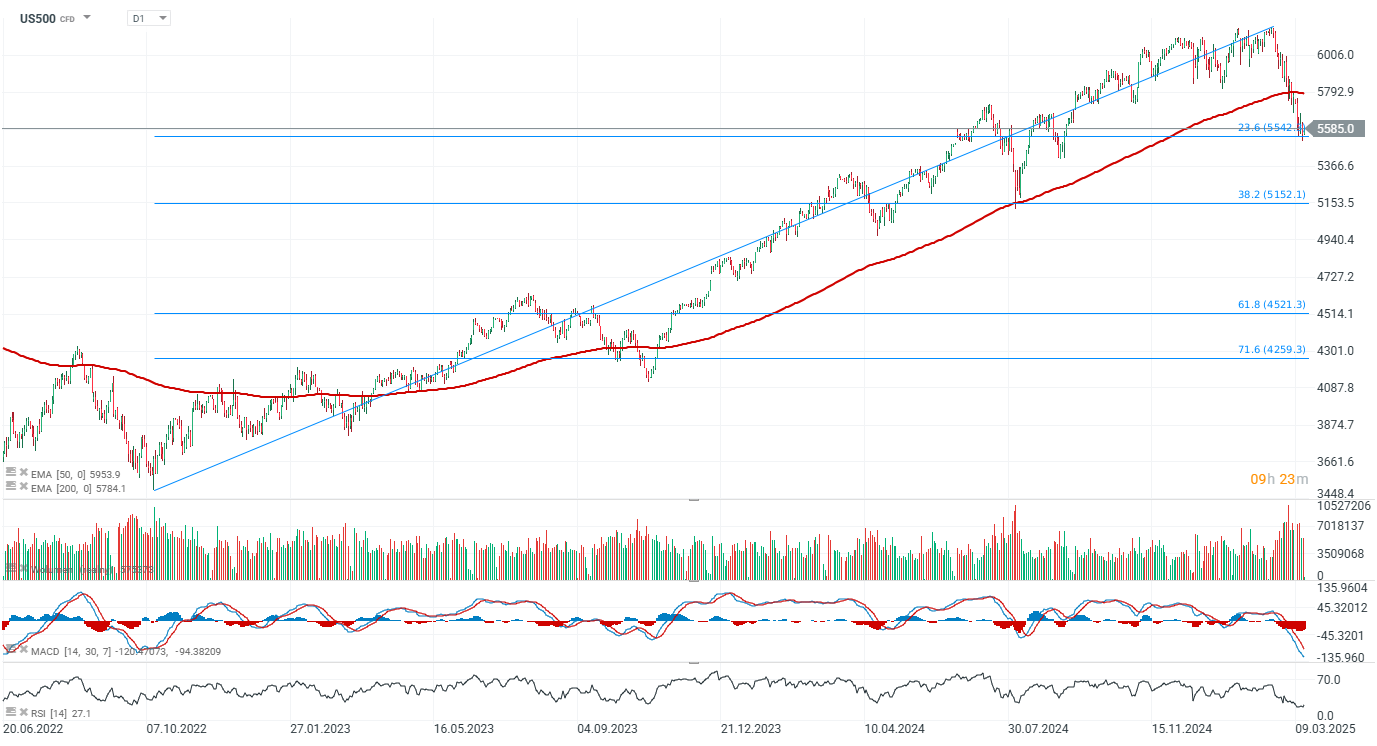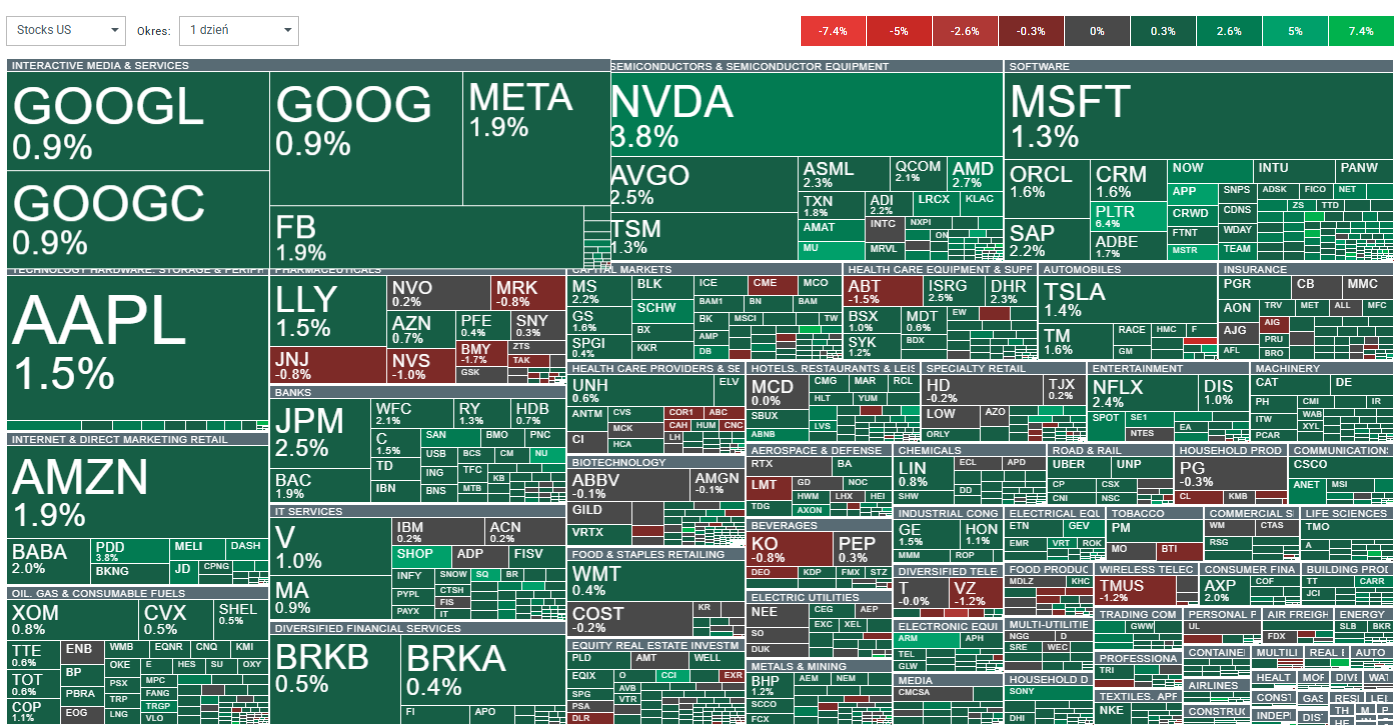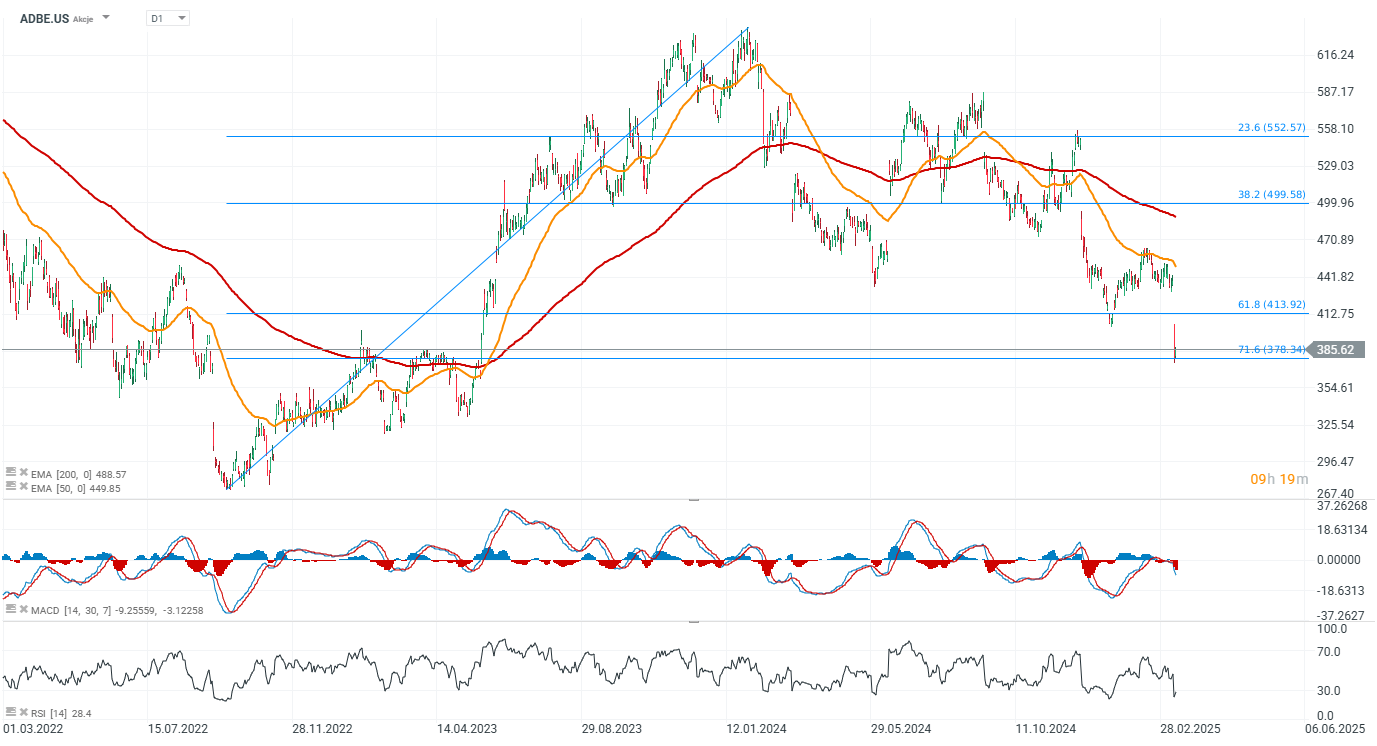S&P 500 futures (US500) are climbing nearly 1% at the market open, led by a strong recovery in Magnificent Seven (MAG7) stocks, particularly Tesla and Nvidia, which is rebounding almost 4%. The reduced likelihood of a U.S. government shutdown has eased investor concerns, providing a welcome relief after the S&P 500 experienced its first 10% correction in nearly two years. Additionally, markets are tilting toward a higher probability of a ceasefire in Ukraine, further supporting risk sentiment. Meanwhile, VIX volatility index is extending its losses following contract rollovers. However, the weak UoM sentiments and rise in inflation expectations pressured sentiments on Wall Street again
- U.S. Dollar Index (USDIDX) is down almost 0.5%, despite a slight uptick in 10-year Treasury yields to 4.3%. 2-year Treasury yields remain below 4%, currently at 3.97%.
-
Bitcoin rebounds above $83,000, gaining over 3%, driving an uptrend in Microstrategy (MSTR.US) and Coinbase (COIN.US) stocks.
- Applied Optoelectronics (APPO.US) soars 41% following a warrant agreement with Amazon (AMZN.US).
- Adobe Systems (ADBE.US) climbs nearly 2%, attempting a rebound after a record selloff yesterday.
- AI-related sentiment is returning to the market, with stocks like Palantir, ServiceNow, and semiconductor companies rallying.
- The University of Michigan Consumer Sentiment Prelim came in much weaker than expected, falling to the lowest since November 2022 & long-run inflation expectations hit a 32-year-high
US500 (H1, D1 interval)
The S&P 500 contract remains within a downward price channel but is attempting to break above the 50-day exponential moving average (EMA50).
Start investing today or test a free demo
Create account Try a demo Download mobile app Download mobile app
Source: xStation5
US500 is trading nearly 200 points below the 200-day moving average, currently positioned around 5,800 points.The decline has paused at the 23.6% Fibonacci retracement level of the 2022 bull run.

Source: xStation5

The technology sector is seeing record gains, while improving sentiment is also evident in U.S. banking stocks.
University Michigan Sentiment Prelim: 57.9 (Forecast 63, Previous 64.7)
- University Michigan Condition Prelim: 63.5 (Forecast 64.4, Previous 65.7)
- University Michigan Expectations Prelim: 54.2 (Forecast 63, Previous 64.0)
University Michigan 5 Yr Inflation Prelim: 3.9% (Forecast 3.4%, Previous 3.5%)
University Michigan 1 Yr Inflation Prelim: 4.9% (Forecast 4.3%, Previous 4.3%)
The UoM report came in much worse than expected, highlighting a surge in inflation expectations (both short and long term), while US consumers expectations fell deeply to 54.2 vs 63 exp.
Biggest Gainers
DocuSign (DOCU.US) – Up 10%
Shares jumped 10% after the company reported stronger-than-expected quarterly earnings and an optimistic outlook for billings revenue.
Peloton Interactive (PTON.US) – Up 8%
Canaccord Genuity upgraded Peloton’s rating, citing its status as the “undisputed leader” in the connected fitness industry.
Radius Recycling (RDUS.US) – Up 100%+
The stock skyrocketed over 100% after Toyota Tsusho America agreed to acquire all shares in cash for $30 per share.
Rubrik (RBRK.US) – Up 20%
Shares of the data security company surged following an earnings and revenue forecast that significantly exceeded expectations.
Allogene Therapeutics (ALLO.US) – Up 7%
The biotech firm rallied after providing updates on its Phase 2 Alpha3 clinical trial.
Ulta Beauty (ULTA.US) – Up 10%
The stock, part of Warren Buffett’s portfolio, soared nearly 10% after Q4 results beat Wall Street expectations and the new CEO reassured investors of minimal exposure to the ongoing trade war.
Adobe slightly rebounds after historic sell-off
Adobe (ADBE.US) saw a sharp 13% drop yesterday after investors reacted negatively to its latest earnings report. Although Q1 results exceeded analyst expectations, the company maintained its full-year outlook, sparking concerns about AI-driven demand growth. While Adobe has been actively integrating generative AI into its products, the revenue impact remains unclear. AI currently contributes less than 1% of its annual recurring revenue (ARR). Also, investors fear economic slowdown risks, compounded by new tariffs under the Trump administration.
Most banks maintain high price targets for Adobe but cut their forecasts following the earnings report:
- Bank of America (Buy, PT cut from $605 to $528) – Solid financials, but concern over Adobe’s shift to targeted AI offerings.
- Jefferies (Buy, PT $650) – Strong execution, but slow AI adoption remains a concern.
- Evercore ISI (Outperform, PT cut from $650 to $550) – Adobe’s valuation remains attractive, but a major stock re-rating would require aggressive buybacks.
- BMO Capital Markets (Outperform, PT cut from $515 to $495) – Neutral on earnings but positive on valuation.
- RBC Capital Markets (Outperform, PT cut from $550 to $530) – Appreciates new subscription revenue disclosures, but sees mixed guidance.
Adobe reaffirmed its FY2025 targets, projecting 11% growth in Digital Media ARR. CEO Shantanu Narayen emphasized that long-term success will depend on customer-driven innovation and the expansion of AI-powered creative tools. However, investors remain cautious, awaiting clearer signs of accelerating AI-driven revenue growth. the Adobe earnings reaction serves as a warning sign for the broader market—investors are demanding more than just stable execution; they want aggressive AI monetization and clearer revenue growth prospects.
Adobe (ADBE.US, D1 interval)
Adobe shares plunged to a new low, with its forward P/E dropping below 30. The stock is now trading nearly 30% below its 200-day EMA (red line), signaling a deeply bearish trend.

Source: xStation5
The content of this report has been created by XTB S.A., with its registered office in Warsaw, at Prosta 67, 00-838 Warsaw, Poland, (KRS number 0000217580) and supervised by Polish Supervision Authority ( No. DDM-M-4021-57-1/2005). This material is a marketing communication within the meaning of Art. 24 (3) of Directive 2014/65/EU of the European Parliament and of the Council of 15 May 2014 on markets in financial instruments and amending Directive 2002/92/EC and Directive 2011/61/EU (MiFID II). Marketing communication is not an investment recommendation or information recommending or suggesting an investment strategy within the meaning of Regulation (EU) No 596/2014 of the European Parliament and of the Council of 16 April 2014 on market abuse (market abuse regulation) and repealing Directive 2003/6/EC of the European Parliament and of the Council and Commission Directives 2003/124/EC, 2003/125/EC and 2004/72/EC and Commission Delegated Regulation (EU) 2016/958 of 9 March 2016 supplementing Regulation (EU) No 596/2014 of the European Parliament and of the Council with regard to regulatory technical standards for the technical arrangements for objective presentation of investment recommendations or other information recommending or suggesting an investment strategy and for disclosure of particular interests or indications of conflicts of interest or any other advice, including in the area of investment advisory, within the meaning of the Trading in Financial Instruments Act of 29 July 2005 (i.e. Journal of Laws 2019, item 875, as amended). The marketing communication is prepared with the highest diligence, objectivity, presents the facts known to the author on the date of preparation and is devoid of any evaluation elements. The marketing communication is prepared without considering the client’s needs, his individual financial situation and does not present any investment strategy in any way. The marketing communication does not constitute an offer of sale, offering, subscription, invitation to purchase, advertisement or promotion of any financial instruments. XTB S.A. is not liable for any client’s actions or omissions, in particular for the acquisition or disposal of financial instruments, undertaken on the basis of the information contained in this marketing communication. In the event that the marketing communication contains any information about any results regarding the financial instruments indicated therein, these do not constitute any guarantee or forecast regarding the future results.

